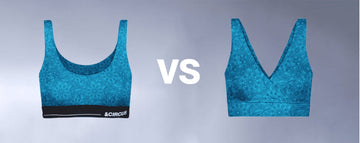Picture this: you're slipping into a pair of underwear that feels like it was custom-made for your body, moving seamlessly with every step, breath, and bend. It's not just soft it's engineered for comfort, backed by data that's as dynamic as you are. This isn't a fantasy from a high-end boutique. It's the future of sustainable innerwear, where video analytics is transforming how brands design for comfort, one frame at a time.
Comfort has long been the holy grail, especially for innerwear. Consumers aren't just asking for eco-friendly fabrics; they want underwear that feels good all day, every day. But comfort is tricky it's personal, subjective, and hard to pin down. Enter video analytics, a game-changer that's turning vague notions of “cozy” into hard data. By blending high-tech cameras, AI, and real-world wear trials, brands are redefining how they measure and deliver comfort, making innerwear that's as sustainable as it is wearable.
The global video analytics market, valued at USD 12.33 billion in 2024, is projected to soar to USD 94.56 billion by 2034, growing at a compound annual growth rate (CAGR) of 22.6%. This boom isn't just about security cameras or retail foot traffic. It's about unlocking new possibilities in design, particularly in the retail apparel sector, where the focus is shifting to hyper-personalized, data-driven solutions.
Uncomfortable underwear shouldn't steal your confidence. At Andcircus, we craft ultra-soft, sustainable Lenzing Modal Micro® innerwear for every body, XS to 5XL. From briefs to bras, our custom packs fit you perfectly. Shop risk-free with our 100% satisfaction guarantee and embrace comfort that includes everyone. #LoveEveryBody. Shop Now!
From Softness to Science: Measuring Comfort in Motion
Gone are the days when comfort was judged by a quick touch of fabric or a vague “feels nice” from a focus group. Today's sustainable innerwear brands are using video to track measurable indicators like thermal regulation, pressure points, and stretch recovery. Imagine a camera capturing how a pair of briefs moves with a wearer's body during a yoga session, or how a bra's straps stay put during a brisk walk. These aren't just pretty visuals they're data goldmines.
AI-assisted video analytics, as noted in a 2023 study on video analytics in retail, can now infer a host of characteristics from footage, from body movement to fabric stress points. Brands are using 360° fit videos to analyze how materials behave across diverse body types, spotting where seams pinch or where stretch falls short. Meanwhile, wear trials think real customers recording their day-long experience in a new sustainable boxer brief are popping up on social media, offering raw, unfiltered feedback that brands can quantify. It's not just about looking good on screen; it's about proving a product works.
Take one sustainable brand that's leading the charge: they film wearers in motion, using AI to map how their bamboo-based fabric holds up under stress. The result? Underwear that stretches just right, without sagging by day's end. Another company posts user-generated videos on platforms like Instagram, showcasing how their organic cotton bras feel after hours of wear. These clips aren't just marketing they're data points, feeding into design tweaks that make the next iteration even better.
Real-World Wins: Brands Putting Video to Work
Sustainable innerwear brands are finding creative ways to harness video analytics. One label uses motion capture footage to A/B test prototypes, comparing how two versions of a boxer brief handle a sprint or a squat. The footage reveals micro-details like how a waistband shifts under pressure that surveys could never catch. Another brand, focused on inclusivity, analyzes 360° videos to ensure their designs fit a range of body types, from petite to plus-size, without compromising on comfort.
Then there's the power of social proof. Real-life testimonials, often shared as shaky phone videos, show customers raving about how a sustainable bra doesn't dig into their shoulders after a long workday. These clips, while not as polished as a studio shoot, resonate with shoppers and provide brands with actionable insights. The AI video analytics market, valued at USD 9.12 billion in 2023 and projected to hit USD 78.57 billion by 2031 with a CAGR of 30.89%, is fueling this trend, enabling brands to process vast amounts of video data for design insights.
The Limits of Looking Comfortable
Video analytics isn't a magic bullet. For all its high-tech promise, it struggles to capture tactile sensations like the buttery softness of organic cotton or the breathability of a hemp blend. A video might show a seamless fit, but it can't convey how a fabric feels against skin. And then there's the privacy hurdle. As the 2023 study warns, video analytics can raise concerns when brands collect user-submitted clips without clear consent, especially if those clips are used to build detailed customer profiles.
There's also the gap between perception and reality. A pair of underwear might look perfect in a 360° video, gliding smoothly over every curve, but feel restrictive after hours of wear. Brands have to bridge this divide, combining video data with other metrics like customer surveys or fabric lab tests to get the full picture. It's a reminder that while video is powerful, it's not the whole story.
Why It Matters: Faster Designs, Happier Customers
So why are brands investing in this tech? For one, it speeds up the design process. Video analytics lets companies spot flaws early, tweaking patterns before they hit production. This means fewer costly returns music to any retailer's ears. It also boosts inclusivity, as brands use video to test designs across a spectrum of body types and movement patterns, ensuring no one's left out of the comfort equation.
The payoff is clear: happier customers. When underwear fits better and feels better, shoppers notice. They're less likely to return a product and more likely to rave about it online, creating a virtuous cycle of trust and loyalty. The video analytics market, projected to grow from USD 10.84 billion in 2025 to USD 84.15 billion by 2034 at a CAGR of 25.57%, is a testament to this shift, driven by the demand for smarter, more efficient design solutions.
A Visual Future for Comfort
The future of sustainable innerwear is looking sharper than ever literally. Experts predict that video analytics will become a cornerstone of fabric R&D, with brands leaning harder into AI to personalize fit and function. Imagine a world where your next pair of underwear is designed based on a video of how you move, tailored to your unique stride or posture. It's not science fiction; it's already happening.
For sustainable innerwear brands, the message is clear: embrace video, but do it thoughtfully. Prioritize transparency, seek consent for user-generated content, and pair video data with real-world feedback to create products that don't just look good but feel like a second skin. Comfort, once a fuzzy concept, is now measurable, trackable, and thanks to video visible. As brands weave together innovation and empathy, they're not just designing underwear; they're redefining what it means to feel good in what you wear.
Frequently Asked Questions
How are videos used to evaluate comfort in innerwear design?
Videos play a crucial role in capturing movement and body responses during wear trials, allowing designers to analyze real-time comfort indicators such as fabric shift, skin irritation, or pressure points. This visual feedback helps optimize fit, stretch, and seam placement to enhance user comfort.
What are comfort metrics in fashion design, and why do they matter?
Comfort metrics refer to measurable indicators like moisture-wicking ability, breathability, pressure distribution, and fabric flexibility. In lingerie and innerwear design, tracking these metrics ensures that garments support daily wear without causing discomfort, especially for sensitive skin or long durations.
Why are sustainable brands investing in video analysis for comfort testing?
Sustainable innerwear brands use video analysis to create data-driven improvements in fit and functionality, reducing returns and waste. By understanding user movement and preferences through video, they can develop long-lasting, body-friendly garments aligned with both comfort and eco-conscious values.
Disclaimer: The above helpful resources content contains personal opinions and experiences. The information provided is for general knowledge and does not constitute professional advice.
You may also be interested in: Male Bodies, Art, & Media: Representation, Communication
Uncomfortable underwear shouldn't steal your confidence. At Andcircus, we craft ultra-soft, sustainable Lenzing Modal Micro® innerwear for every body, XS to 5XL. From briefs to bras, our custom packs fit you perfectly. Shop risk-free with our 100% satisfaction guarantee and embrace comfort that includes everyone. #LoveEveryBody. Shop Now!







































